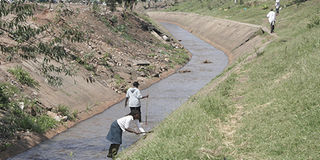Life slowly returns to Nairobi River

Flowing freely again, Nairobi River is a far cry from the sludge of mud it was not too long ago, thanks to a project spearheaded by the Environment Minister John Michuki. Now, those who live and work along the course are even drawing water from it. Photo/JAMES NJUGUNA
What you need to know:
- Michuki project cleans it up and other streams and gives hope to residents
Nairobi residents may soon start fishing from a river which only a few months ago was a mobile waste dump --- the Nairobi River.
The mudfish (commonly known as Kamongo) already survives in some sections of the river, previously of stagnant raw sewage, untreated industrial effluents and other solid waste.
And when the “Nairobi fish” graces local markets, it will be one more big score for a man known to get things done once he is in charge--—Environment minister John Michuki.
When he got down to rehabilitate and restore the river in April this year, few believed that water would ever cascade through the meanders down some of the city’s densely populated informal settlements.
Today, water on the 2.5-kilometre stretch — from the museum round about down Kijabe Street, to the Globe Cinema roundabout is clear, and where it is still unclear, it is not harmful to human health.
This week, a Saturday Nation team could see mudfish popping out of the water and several fish eating birds such as herons hovering over the waters, their eyes trained on their potential prey.
To attain this level of cleanliness, more than 700 tonnes of garbage were removed from the sites, according to National Environment Management Authority (Nema), deputy director Betty Nzioka.
The Nairobi Rivers Basin Rehabilitation and Restoration Programme is only on its first phase, and as Mrs Nzioka says, fishing could be one of the main economic activities by the third year.
The Nairobi River basin consists of Mathare river and the almost extinct Ngong river.
Both Mathare and Nairobi rivers flow from the Kikuyu and Limuru catchment area before they meet east of Nairobi after Kariobangi estate. They flow further eastwards and converge near Njiru area with what could be Ngong river.
However, Ngong river, environment experts now say, is no more than flowing sewage waste after it was subdued by toxic industrial waste on its way from Nairobi dam in Lang’ata.
It had flowed from Mutui-ini swamp and Dagoretti forest as Mutu-ini river before it got choked by industrial waste as it meandered past Mombasa Road, industrial area and the Mukuru slums.
“We want all the three rivers’ ecosystem to sustain life,” says Mr Michuki. “I will not stop until I see people fishing from the three rivers. It is a huge task, but we are headed there.”
And when this man speaks so passionately about an action he wants to take, you got to believe him. Though the idea of the initiative was mooted and documented in 1999, it only needed the thrust of Mr Michuki to see it roll on.
“People have only been putting things down on paper,” he he told the Saturday Nation in an interview. “But having them implemented is another different thing. There are people who would not have wanted the river to be cleaned because they thrive on the filth.”
“Some of the workers recruited through the Kazi Kwa Vijana initiative are on the security trail watching out for anyone intent on violating the river by either dumping waste or trespassing on its riparian section.”
But despite the hawk eyes of “Nairobi river askaris” (as the security team is being referred to), some streetboys and mechanics nearby are already making sumptuous meals out of the more than 1kg fish.
“Tunawapiga chenga hawa makarao wa mto tunapata mlo. Ziko poa jo” (Sometimes we are outdoing the river’s security team and get the fish. They are delicious)”, says Kamau aa Wanja, a streetboy.
It was not immediately possible to get the exact fish population, but the mere fact that they can survive in the river is a milestone on the work being done by the Environment ministry, to restore the river’s lost glory.
Ms Mary Bell, a worker at the Nyayo market stretch says the fish are many in the mornings when they swim downstream towards Gikomba.
“Sometimes we accidentally step on them. They can be seen in the mornings, before 9am and past 5pm in the evening as they move upstream,” she says.
Peter Karanja who has worked near the globe roundabout since April, says there are also crabs, scorpions and water beetles that can bite a bare foot. “We see them regularly, but we are well protected,” he says.
According to the minister, experts have indicated to the ministry that “one cannot die” by consuming this water. “They have told us where we have water beetles, it means the water has no toxic materials,” he says.
The river’s clean-up, now on its seventh month, is an apt testimony that it is not a mirage to restore the ecosystem in the three years the project is set to be completed.
Once the rivers’ basin is cleaned up, the city’s garbage eyesores will be no more.
According to a report prepared by Nema, the main eyesores are at the South B bridge, near Mater Hospital, the Kwale area of Donholm, Lunga Lunga in Industrial area, Enterprise Road and the stretch from the Globe roundabout, Nyayo market in Ngara and the Gikomba area, which is now clean.
According to the Sh15 billion project proposal, published in November last year, the initiative aims at restoring and managing the rivers ecosytem to improve the residents’ livelihoods and provide them with a sustainable water supply for domestic, industrial and recreational use.
The Saturday Nation also learnt that the banks of the river behind Kijabe Street and Kipande Road where several types of indigenous and fruit trees have been planted will be turned into a public park.




